Wildebeest: Facts, Lifespan, Size, and All You Need To Know
Wildebeest Facts, Lifespan, Behavior, Size, Diet, Habitat, Weight, and Face
Wildebeest: Facts, Lifespan, Behavior, Size, Diet, Habitat, Weight, and Face. Learn about Wildebeest herds with Africa Safari Experts. Visit Kenya and Tanzania.
The Wildebeest are often called gnus and are the dramatic, shaggy-bearded protagonists of Africa’s grasslands: stocky, powerful antelopes built for endurance and sudden, explosive movement. There are only two living species (the blue or brindled wildebeest and the black wildebeest) in the genus Connochaetes, and their behaviour combines tight herding, seasonal breeding, and an almost cinematic instinct to move with the rains in search of new grasses. Their appearance (curved horns, a sloping back, and a coarse mane) and relentless migrations make them irresistible to photographers, naturalists, and anyone who loves big-wildlife spectacle.
Where you’ll see them: the blue wildebeest ranges across East and southern Africa, famously forming the millions-strong herds of the Serengeti–Masai Mara ecosystem, while the black wildebeest is largely a southern-African species. The “Great Migration,” driven by rainfall and fresh grazing, moves roughly a million-plus wildebeest (along with zebras and gazelles) around Tanzania’s Serengeti and into Kenya’s Masai Mara each year, creating one of the world’s most iconic wildlife events; smaller, resident populations occur across countries from Angola and Zambia down to South Africa. If you want to witness raw, pulsing wildlife energy, follow the rains, and you’ll follow the wildebeest.
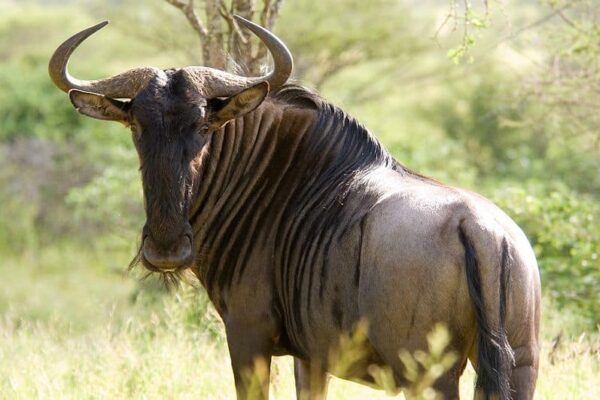
Facts
Wildebeest (genus Connochaetes), commonly called gnus, are stocky, muscular antelopes with two living species: the blue (or brindled) wildebeest and the black wildebeest. Blue wildebeest form the vast, migratory herds of the Serengeti–Masai Mara ecosystem, while black wildebeest are primarily found in southern Africa. Wildebeest are ecologically important as bulk grazers: their seasonal movements shape grassland dynamics, nutrient flows, and predator behaviour. The “Great Migration” sees roughly a million wildebeest (plus zebras and gazelles) move annually in search of fresh pastures, creating one of the planet’s largest terrestrial animal movements.
Lifespan
Wildebeest longevity varies by context: in captivity, they commonly live around 20 years, with some individuals reaching into their mid-20s; in the wild, their lifespans tend to be shorter, often limited by predation, disease, and the rigours of migration. Juvenile mortality can be high during droughts or when herds are fragmented by fences or habitat loss. Successful calving seasons, access to water, and avoidance of disease (including spillover from domestic livestock) strongly influence cohort survival. Protected areas that preserve migratory routes and water sources increase the chance that more wildebeest reach older ages compared with fragmented, human-dominated landscapes.
Behavior
Wildebeest are highly social and gregarious: they form large, fluid herds that provide safety in numbers and synchronize behaviours like calving. During the annual cycle, they follow seasonal rains and newly emergent grasses, often in tight company with zebras and gazelles; zebras remove the upper, coarse grass layer and expose the greener sward that wildebeest prefer. Males establish territories or temporary harems during the rut, using dung heaps, scent marking, and displays to attract females. Herds show coordinated movement, vocalizations, and alarm responses, yet individuals will sprint, swim rivers, and scatter to evade predators such as lions, hyenas, crocodiles, and wild dogs.
Size
Wildebeest are robust and built for endurance rather than speed bursts like cheetahs: adult blue ones can reach up to roughly 2.4 m (8 ft) in body length; shoulder height varies around 1–1.5 m depending on sex and subspecies. Their forequarters are heavy and muscular, giving a sloping back from shoulder to rump; both sexes carry distinctive curved horns that form a protective “helmet” for the head. Sexual dimorphism is present: males are generally larger and darker, while females are slightly smaller, an anatomy that supports long-distance movement, sudden bursts to escape predators, and dominance battles during mating season.
Diet
Wildebeest are primarily grazing herbivores that favour short, nutrient-rich grasses common on savanna plains. Their broad muzzles and high daily intake let them consume large quantities of sward quickly, which is ideal during the short-window flush of post-rain growth. When grass is scarce, They will browse shrubs, consume forbs, or rely on underground moisture sources (roots, tubers, or melons in drier habitats). Their foraging often pairs them with zebras and grazers that open up palatable layers, and this dietary flexibility helps wildebeest persist across wet and dry seasons—so long as migration routes and watering areas remain accessible.
Habitat
Wildebeest inhabit open to lightly wooded savannas, grasslands, and plains where water and grazing are seasonally available. Blue wildebeest range widely across East and southern Africa, the Serengeti–Masai Mara region is the most famous migratory stronghold, while black wildebeest occur mainly in southern African grasslands and karoo-edge habitats. They favor landscapes with spatially predictable water and calving grounds; fences, agricultural expansion, and habitat fragmentation that interrupt migration corridors can cause mass die-offs by cutting animals off from wet-season pastures or watering points.
Weight
Adult blue wildebeest weights vary by sex and region: mature individuals frequently weigh between about 120–270 kg (roughly 260–600 lb), with large males at the upper end of that range. Black wildebeest tend to be somewhat lighter-bodied but still robust. Weight fluctuates seasonally, animals gain condition on abundant wet-season forage and lose mass during dry-season migrations and food scarcity. Body condition influences dominance, mating success, and calf survival; consequently, populations that lose access to key grazing areas or water during dry spells will show measurable weight declines and lowered reproductive output.
Face
The wildebeest’s face is unmistakable: a broad, blunt muzzle for cropping grass; a beard-like mane and a tufted, long tail that can be flicked to communicate alarm or swat flies; and a dark, often elongated facial mask contrasting with paler cheek or throat patches on some subspecies. Both sexes carry stout, crescent-shaped horns that sweep outward and upward from the skull, framing the face and serving both defense and intraspecific combat. Facial scent glands and visual cues (posture, ear orientation) play roles in social signaling, while the facial structure supports rapid intake of grass during short feeding windows on migration.
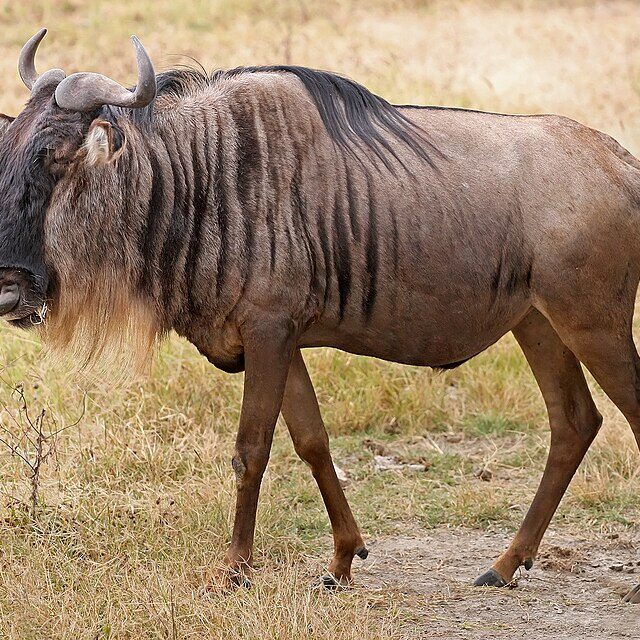
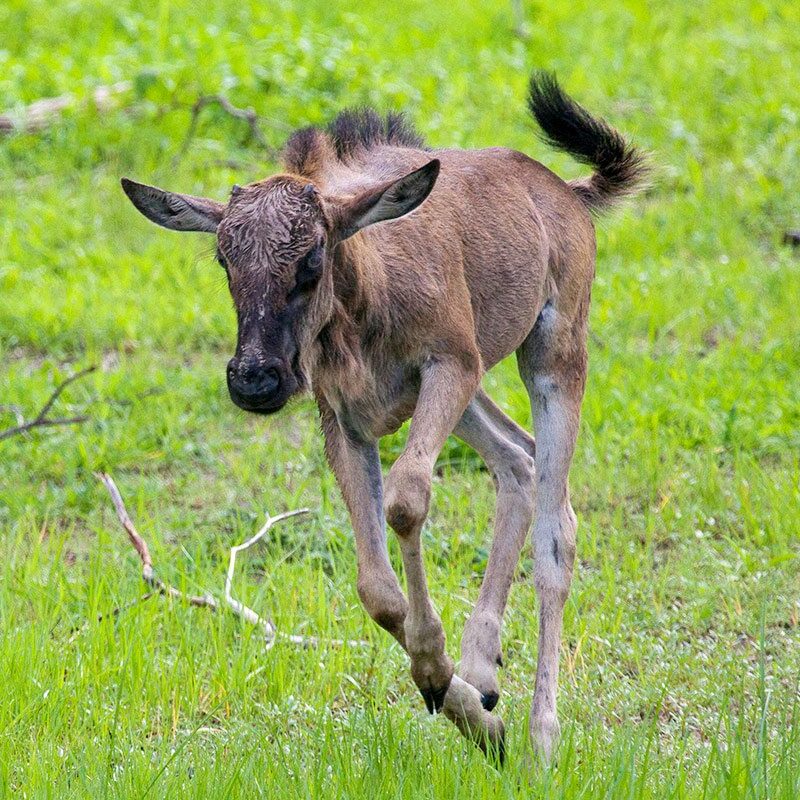
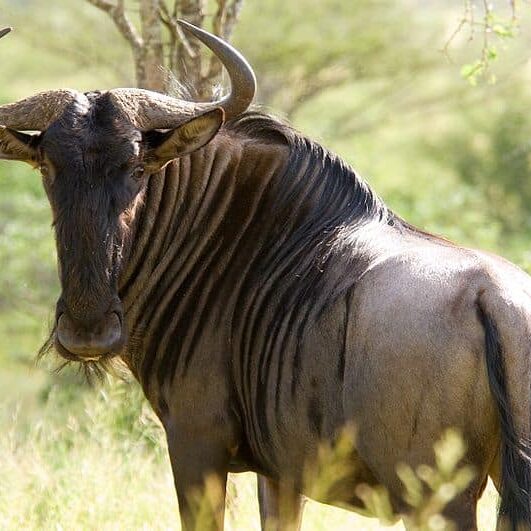
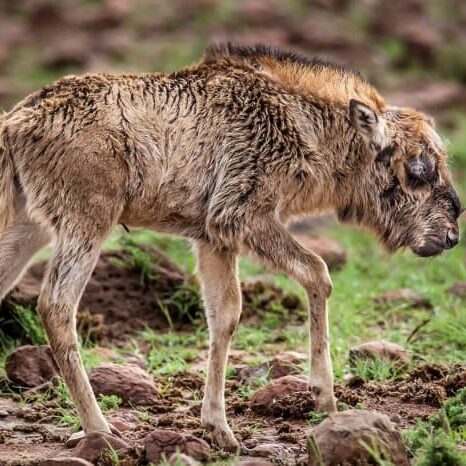
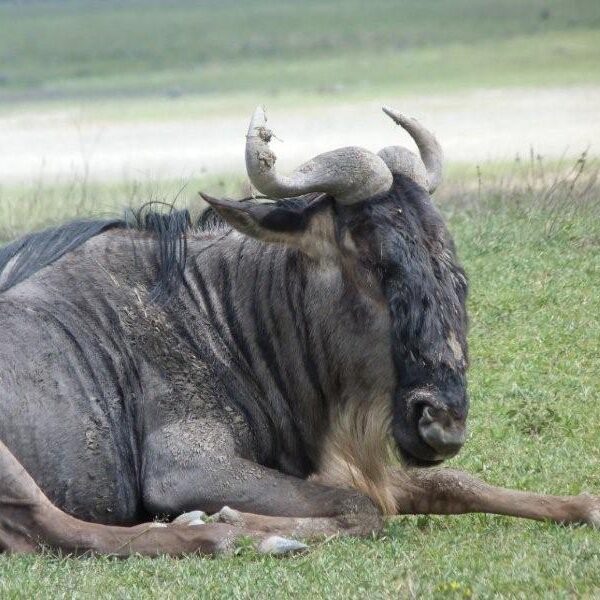
Let’s Help You Plan Your Affordable Luxury Gorilla Trekking Tours In Africa.
Embark on the ultimate Affordable Luxury Gorilla Trekking Safaris with Africa Gorilla Trek in Uganda, Rwanda, and Congo, where exclusivity meets adventure in the heart of Africa’s pristine rainforests. Our bespoke gorilla trekking itineraries offer intimate encounters with majestic mountain gorillas, guided by expert trackers in world-renowned parks like Bwindi Impenetrable Forest, Volcanoes National Park, andVirunga National Park. Indulge in luxurious eco-lodges, personalized services, and seamless private transfers, ensuring a stress-free and unforgettable journey. Whether you seek short gorilla treks or Long extended safaris, we craft tailor-made experiences blending wildlife, culture, and relaxation. Book your exclusive Private Luxury African Safari today and discover the untamed beauty of Africa in unparalleled comfort!